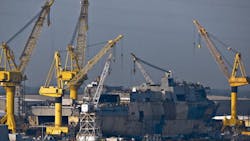Shipbuilders Pump $36 Billion Annually into Economy
Rising shale oil production is contributing to the surging health of America’s commercial shipbuilding industry, according to Matthew Paxton, president of the Shipbuilders Council of America (SCA). He gave that assessment this week in his testimony before the House Subcommittee on Coast Guard and Maritime Transportation.
"Commercial markets are witnessing a boom not seen in decades, representing billions of dollars in new investments to our economy,” he said. “This is all while American shipyards continue to deliver the largest and most sophisticated Navy and Coast Guard in the world.”
In 2012, U.S. ship builders delivered 1,260 vessels worth more than $20 billion in revenue, according to a recent study conducted by the Maritime Administration. Nationwide, the U.S. shipbuilding and repair industry supports more than 400,000 jobs, which pumps $36 billion into America’s economy.
Over the past year, U.S. shipyards entered into hundreds of contracts for new vessels, including the construction of state of the art oil tankers and the world’s first LNG-powered containership that the White House recently called “critical to the future of maritime transportation.” Paxton noted that vessels under construction will add almost 6.4 million barrels of new capacity to the domestic fleet in addition to the more than 8.2 million barrels of capacity that were added last year.
“Shipyards also have a big impact on their local communities and the country at large,” Paxton added. “With more than 300 facilities located in 27 states, and a supplier base that can be found in all 435 Congressional Districts, each direct job leads to almost three indirect jobs nationally.”
Mark Tabbutt, chairman of the board of Saltchuk, a transportation and distribution service provider, testified on behalf of the American Maritime Partnership (AMP). He added that today’s containerships, roll-on/roll-off vessels, dredges, offshore supply vessels, large articulated tug-barges and tankers are more productive, energy efficient, and environmentally friendly than ever.
“The American domestic maritime industry is doing its part to help address the transportation changes,” he said. “There are 22 new large tankers and articulated tug-barges under contract, not including options for future construction. We have inland shipyards in this country that are building and launching, on average, almost a new barge every single day of the year. New tugs and towing vessels are also being built to handle that increased demand.”
